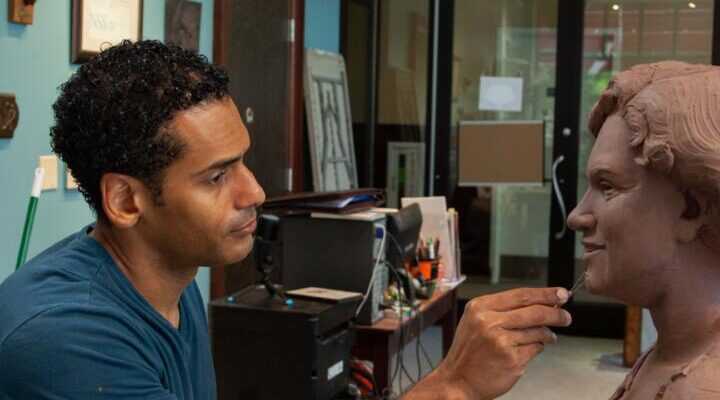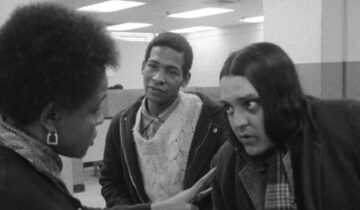Interview by Amber Thompson, Marketing & Communications Coordinator
Local sculptor LaQuincey Reed, who uses the same lost-wax method of sculpting that Auguste Rodin used, will be conducting two Artist’s Perspective Tours of True Nature: Rodin and the Age of Impressionism alongside OKCMOA’s Head of Education Bryon Chambers on Sunday, August 6, and Saturday, October 7.
LaQuincey, who is currently part of the Skirvin Hilton Hotel and Paseo Arts Association’s Artist in Residence program, graduated from the University of Oklahoma with a BFA in studio work. In his studio space at the Skirvin, he is working on, among many other projects, a sculpture of civil rights activist Clara Luper, which will be part of the Clara Luper Sit-In Plaza at Robinson and Main in Oklahoma City, and a bust of Pearl Mesta, socialite and daughter of Skirvin founder William Balser Skirvin. This interview was conducted in his studio, which is open to the public.
OKCMOA: What was your path to becoming a sculptor like?
LaQuincey Reed: As a kid I was always drawing with my uncles, drawing superheroes on my grandmother’s front porch. I think that’s how a lot of people start these days.
I probably took my first sculpting class as a junior in college. I was doing both painting and sculpting. Then when I graduated, I was an assistant on the Land Run monument. I remember sitting there thinking, “I’m not really progressing in painting like I want to be.” I put the paintbrush down and decided, “I’m going to focus on sculpture.”
What types of things did you work on as an assistant on the Land Run Monument?
I did a lot of reins and buckles. Underneath horses, the backs of legs, some of those small details. I’d say he [artist Paul Moore] did 85-90% of it himself, which is unusual.
Do you still draw? Is it part of your sculpting process?
Not like I used to. I used to draw every single day. I had a sketchbook full of ideas. Now I’ll draw if I feel like I need to shift the head this way or bump a shoulder of a work up a little, making it a little more animated. For a portrait bust, typically not, but everything else, there’s typically a little drawing involved.
What were some of the obstacles you encountered when it came to making sculpting your career?
The main problem is the cost. People love bronze, but they don’t want to pay bronze prices. But you really want that because it’s something that will last hundreds of years. It’s like the plaster casts that they would exhibit during these huge exhibitions, world’s fairs. A lot of these artists would just be hoping someone would see their work and think, “I want that in bronze.”
As far as trying to navigate my career, I’d talk to established artists, and they’d be really complimentary of my work, and I’d ask them, “What can I do to progress? What can I do to take my art to the next level?” And they’d just say, “Keep doing what you’re doing. Just get out there, do the work, keep meeting people.” So that’s what I’m trying to do. I had to learn there’s no magic trick to it.
What is your experience with how people interact with art in general and with your art in particular?
It varies. People graffiti art, stand on top of art. I’ve even seen other artists do that for Instagram. I’ve seen people astonished that someone could create something, especially figurative art, which is what I do, with their hands. Sometimes a work brings back memories or stories that people have about the place they’re at.
One thing I’ve noticed at the Skirvin is that Western art isn’t something another region really has, so this is something that visitors are really drawn to when they come here.
Is it important to create work that feels familiar to people in order to tell the stories you want to tell?
A lot of times, because we’re people, we’re vain. Something looks like a person, and we see ourselves. It could be a stick figure. It helps create a better interaction with people. It’s not objective, the starting off point being yourself.
What is the most challenging part of being a visual artist in Oklahoma? Is there a period of art history you draw inspiration from when it comes to overcoming some of those challenges?
I think we’re starting to see a new appreciation of Oklahoma artists. In a place like Santa Fe, or any city that’s a big art hub, the arts have been taken more seriously there. People would go there to buy work by an Oklahoma artist, instead of buying it here. There’s a greater interest now in supporting the artists we have living and working here. I’m also trying to navigate my own path forward, keep doing the work, not just one or two pieces but a bunch of work. Don’t say “no;” try to say “yes.”
At the same time, the guys who inspire me are the ones who failed early in their career. Even Rodin kind of floated around. He was really much more of a craftsman, doing the work in other peoples’ studios until his forties.
Rodin would often reuse elements in his works, like hands or feet, which might not always be easy to see unless a person is looking for it. Do you do this in your work, and, if so, do people seem to notice?
I do sometimes incorporate things into other pieces. Like that gold bust behind you. I really like her face so I might use that in something else. People are kind of funny about what they notice. Sometimes they’ll come in here and the first thing they point to and ask about isn’t the biggest piece in the room; it’s something tucked away on a bottom shelf.
Even though you’re no longer teaching, does that still impact the way you work or the way you think about how people experience your art?
It does. I find that I’m treating myself like a student, talking to myself. As I’m working, I’ll ask, “Why are you doing that?” “What result are you hoping to get?” “What happens if you do this?”
I’m also looking for mistakes. Does the positive and negative space work? Does the texture communicate what I want? Sometimes you have to take a step back because it’s like looking at one tree all day and not seeing the forest.
What would you want an exhibition to highlight a hundred years after your works were created?
I would hope that the work I do, especially Blacks in the West, would be part of that. They’re confident; they’re strong, capable. Talking about the West, we’re often talking about how downtrodden they were. But they were confident in their abilities. Those are feelings everyone can experience.
What has the reception of your Black cowboy work been like?
We’ve got this idea in our heads that different perspectives won’t be accepted, but that’s not true. You’ll find eventually those people who’ll be a champion for you. Some people are more interested in art that depicts a specific person and not all of my work does, but overall, the reception has been positive.
Is there a particular person or story you’d like to highlight in your art that you haven’t had the opportunity to yet?
I’m in talks with the city of Cheyenne [WY] for a public works project focused on Nat Love. He was a farmer born into slavery in Tennessee, and when slavery ended, he was eventually able to get his family to a point where they were self-sustaining. He ended up working as a porter on the railroad. He saw the rise of the Old West and the fall of the railroad. He lived through these three eras of American history, and he wrote his autobiography as well.
Another is a Black cowboy in New Mexico who was looking out into this washed-out basin and saw something that made him think, “I wonder what’s down there?” He had discovered a huge archeological site.
Besides here at the Skirvin, where else can people see your art?
My busts of Clara Luper and Chief Allen Wright are at the Oklahoma Capitol. At Oklahoma Baptist University there’s a sculpture of James R. Scales, who was president there and then went on to Wake Forest University.










